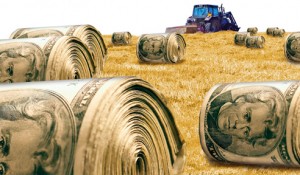Farm Subsidy Cuts Finally On Table
 The Wall Street Journal reports:
The Wall Street Journal reports:
WASHINGTON—The hunt for cuts has come to this: Even agriculture subsidies—billions in spending both parties have embraced for years—are on the table.
With the farm economy booming and Washington on a diet, a program set up in the 1990s that cuts checks to farmers could be trimmed or eliminated next year when Congress writes a new five-year farm bill.
A group of conservative lawmakers has set its sights on these direct payments, and even farm-state Democrats who like the program say high crop prices make the outlays of about $5 billion a year harder to justify. Recently, the National Corn Growers Association, an industry lobby group, urged Congress to revamp the program, fearing it would be eliminated altogether.
Washington is looking everywhere for savings, even to programs once viewed as sacrosanct, including farm programs and defense spending.
Republican House Budget Committee Chairman Paul Ryan's blueprint for the fiscal 2012 budget puts agriculture subsidies in the cross hairs, seeking to cut $30 billion over a decade—starting when the next farm bill is passed in 2012—out of a total of some $150 billion in total expected spending on farm subsidies.
"We are very focused on getting a grip on spending—that means a lot of things even I like," said House Agriculture Committee Chairman Frank Lucas (R., Okla.) The direct payments have "a target on them," said Sen. Mike Johanns (R., Neb.), a former supporter of the program.
The farm payments at risk were supposed to be temporary. Lawmakers designed the program in the 1996 farm bill to wean farmers of rice, feed grains, cotton and later soybeans off years of subsidies tied to keeping portions of land fallow.
The direct payments have endured and are now a cornerstone of American farm subsidies. The $5 billion in direct payments to farmers accounts for a third of the roughly $15 billion in total farm subsidies last year, according to government data.
Benefiting are about one million farmers on 260 million acres of land spread around 364 of 435 congressional districts, according to the Agriculture Department and the Environmental Working Group, a organization that wants to eliminate some farm subsidies and use the money to protect natural habitats.
With the farm sector booming—the USDA estimates net farm income this year will be the second-highest in 35 years—direct payments have become an easy target.
Click here to read more.

